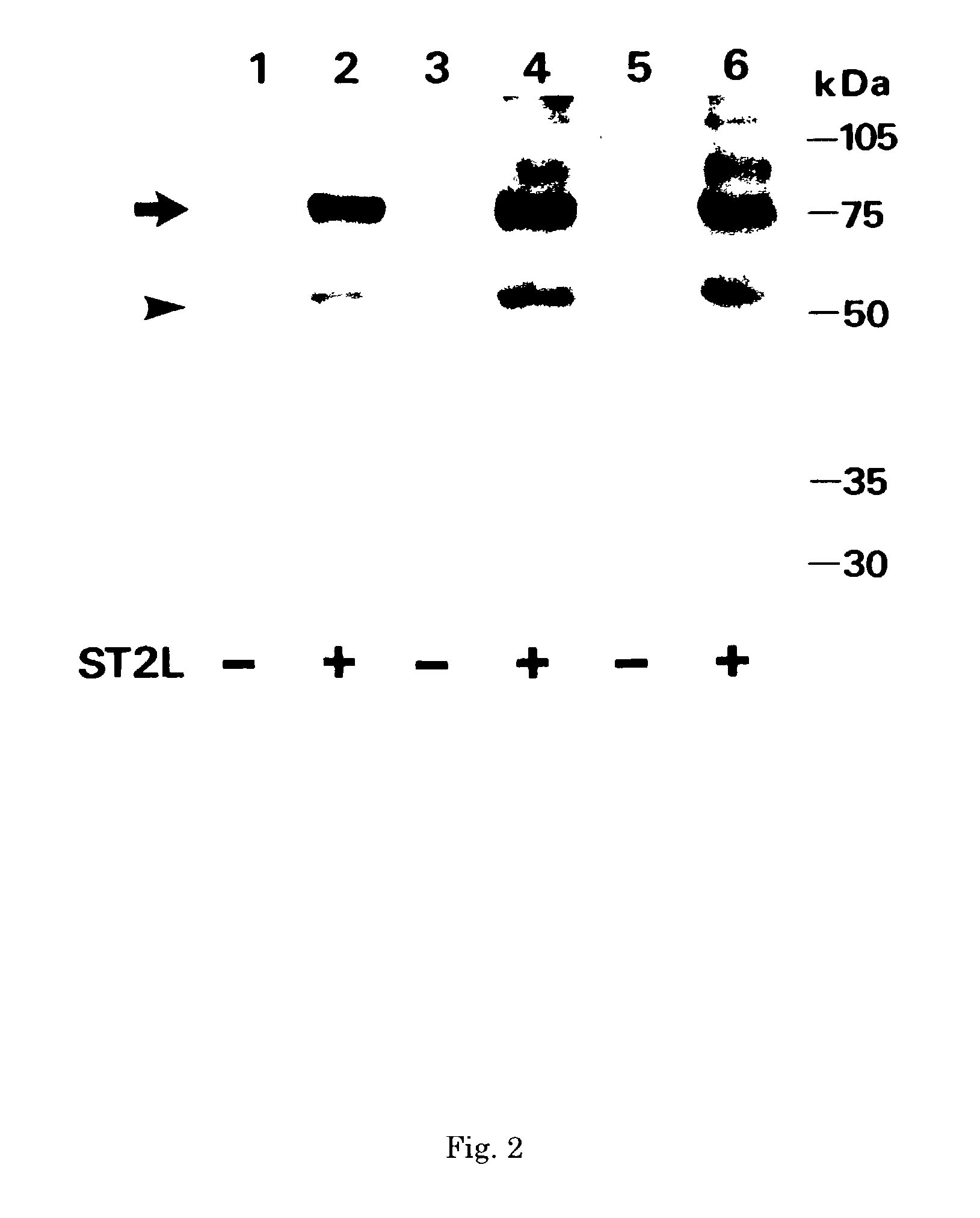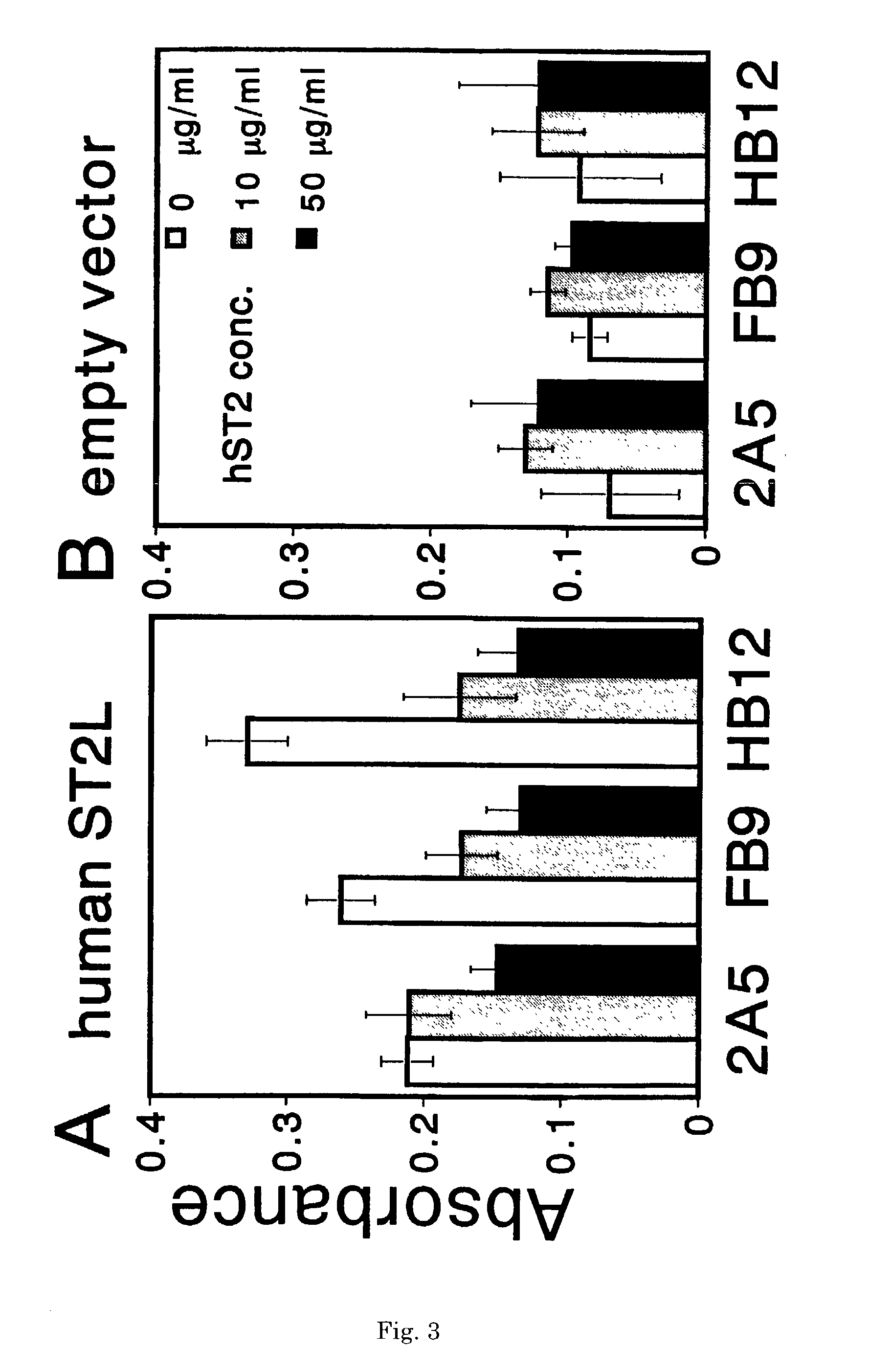Monoclonal antibody and method and kit for immunoassay of soluble human ST2
a human st2 and monoclonal antibody technology, applied in the field of monoclonal antibody and method and kit for immunoassay of soluble human st2, can solve the problems of not being able to recognize a specific non-denatured human st2, no satisfactory biological data have been obtained, and the physiological function of this antibody has not been clarified. , to achieve the effect of rapid and convenien
- Summary
- Abstract
- Description
- Claims
- Application Information
AI Technical Summary
Benefits of technology
Problems solved by technology
Method used
Image
Examples
example 1
Preparation of Monoclonal Antibody Binding Specifically to Non-denatured Human ST2
(1-1) Preparation of Antigen
[0092]Two different antibodies were employed to obtain a monoclonal antibody binding specifically to a non-denatured human ST2 (hereinafter referred to as hST2). The first antigen employed was a soluble recombinant hST2 which was produced and secreted in a COS7 cell into which an hST2 gene had been transduced. The second antigen employed was a COS7 cell expressing a chimera molecule HMS whose extracellular region corresponded to a human ST2L (hereinafter referred to as hST2L) and whose transmembrane region and intracellular region corresponded to a mouse ST2L. The method for preparing each antigen is described below.
a. Preparation of Soluble Recombinant hST2 (rhST2)
[0093]An expression vector containing all coding region of a human whole length ST2 cDNA (Sequence ID No.1) (pEF-BOS-ST2H) was constructed and transfected into a COS7 cell (see Tominaga S., et al.,: Biochim. Bioph...
example 2
Examination of Monoclonal Antibody Activity
a. Immunoblotting Method
[0112]In order to examine the monoclonal antibodies 2A5, FB9 and HB12 obtained as described above for their activities on the hST2, an immunoblotting method was employed.
[0113]First, the rhST2 purified partially on a heparin agarose column in Section a in (1-1) described above was developed by a 10% SDS-PAGE and then transferred onto a PVDF membrane filter. Subsequently, the filter was cut into strips, and each filter was blocked with 10 mg / ml skim milk dissolved in a 0.05% (v / v) solution of Tween 20 in a tris buffered physiological saline (T-TBS; pH 7.5). Then each filter was reacted with the purified monoclonal antibody obtained in (1-5) described above dissolved in a skin milk / T-TBS. After reacting for 1 hour, the filter was washed three times with the skim milk / T-TBS, and reacted with an HRP-binding goat anti-mouse IgG dissolved in the skim milk / T-TBS for 30 minutes. After washing three times, the bands of the pr...
example 3
Reactivity of Monoclonal Antibody with Non-denatured hST2 and Epitope
(3-1) Cell ELISA Method
[0119]It was examined whether monoclonal antibodies 2A5, FB9 and HB12 were capable of recognizing a non-denatured hST2 or not by a cell ELISA employing a viable cell which was expressing the hST2L on its cell surface.
[0120]A COS7 cell was transfected with a pEF-BOS plasmid obtained by integrating the hST2LcDNA into the expression vector pEF-BOS, and the transfected cell was incubated in a 96-well plate for 48 hours. Subsequently, each well was made free of the culture medium, and charged with each monoclonal antibody labeled with the HRP, together with a varying concentration of the rhST2. Thereafter, the plate was incubated in the presence of 5% CO2 at 37° C. for 15 minutes. After these reactions, the cell in each well was washed three times with a PBS gently, and the HRP enzymatic activity in each well was assayed.
[0121]The graph of results of the assay are shown in FIG. 3. In the figure gr...
PUM
| Property | Measurement | Unit |
|---|---|---|
| pH | aaaaa | aaaaa |
| pH | aaaaa | aaaaa |
| pH | aaaaa | aaaaa |
Abstract
Description
Claims
Application Information
 Login to View More
Login to View More - R&D
- Intellectual Property
- Life Sciences
- Materials
- Tech Scout
- Unparalleled Data Quality
- Higher Quality Content
- 60% Fewer Hallucinations
Browse by: Latest US Patents, China's latest patents, Technical Efficacy Thesaurus, Application Domain, Technology Topic, Popular Technical Reports.
© 2025 PatSnap. All rights reserved.Legal|Privacy policy|Modern Slavery Act Transparency Statement|Sitemap|About US| Contact US: help@patsnap.com



